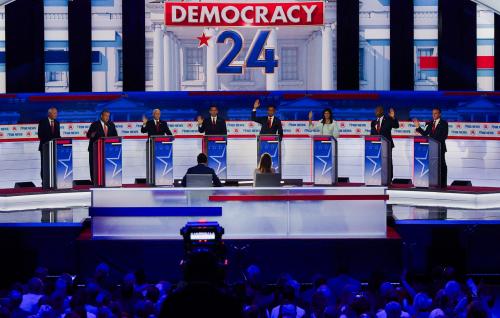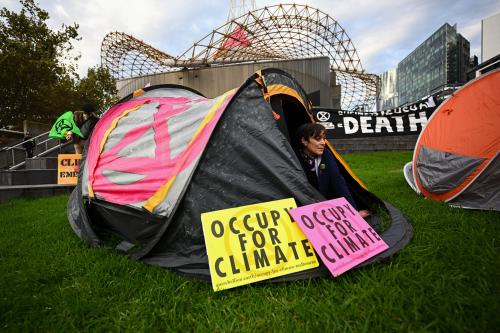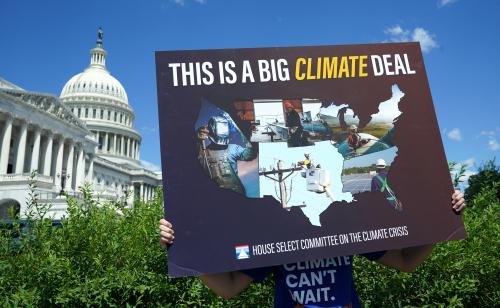The recent natural gas ‘revolution’ in the United States has encouraged a nationwide shift in its energy consumption patterns. An abundance of unconventional natural gas (with help from a patchy economic recovery) has allowed for sustained low natural gas prices. With prices currently hovering just over $3/mmBtu, many energy consumers – most notably power generators, manufacturing and petrochemical producers, and potential consumers of natural gas for transportation – are turning their attention to natural gas. But one natural gas consumer is generating the most controversy for its demand for the new bounty: natural gas exporters.
In May 2012, we co-authored a report, ‘Liquid Markets: Assessing the Case for Exports of Liquefied Natural Gas’. In that study, we argued that the US government should neither prohibit nor promote liquefied natural gas (LNG) exports and that, by allowing the free market to allocate gas to its most economically efficient end-uses, the United States will reap both economic and geopolitical benefits. We still firmly support that conclusion. As we stated then: ‘As a principal advocate and beneficiary of a global trading system characterized by the free flow of goods and capital, the United States has a long-term economic and political incentive to refrain from intervention in the market wherever possible.’
The Protectionist’s Argument
As the policy currently stands, prospective exporters must submit applications to the US Department of Energy (DoE) for the right to export LNG to countries that have a free-trade agreement (FTA) with the United States and to those that do not. DoE is required to approve any application to export LNG to FTA nations ‘without delay’. With respect to countries that do not have an FTA with the United States, DoE reviews each proposal and can only deny the application if it finds that exports are not in the public interest. (It is important to note that aside from South Korea, the United States does not have an FTA with any major LNG importing nation.) To date 17 projects have applied to DoE to export a total of more than 24 billion cubic feet of LNG a day (bcf/d) to countries that do not have a free-trade agreement with the United States. Only one of these projects – Cheniere Energy’s Sabine Pass terminal – has received full approval from DoE to export to non-FTA nations; it has also received regulatory approval and is expected to begin exports from its Louisiana terminal by 2016.
Opponents of Cheniere’s project and other prospective LNG exports are a diverse group. Some industrial gas consumers, manufacturers, and petrochemical producers argue that LNG exports will hurt the competitive advantage provided to them by abundant, cheap domestic natural gas feedstocks, a benefit not enjoyed by their Asian and European competitors. Dow Chemical, the industrial giant that is one of the more vocal industry critics of LNG exports, frequently asserts that the natural gas ‘revolution’ will trigger a manufacturing renaissance, which it estimates will add $90 billion in new investments to the US economy. ‘We are all for exporting natural gas. We just want to see it exported in solid form instead of liquid form’ said Andrew Liveris, Dow’s CEO at CERA Week, an industry conference, in 2012.
Mr. Liveris’ views are shared by some politicians in Washington. The most vocal opponent of LNG exports on Capitol Hill is Congressman Edward Markey of Massachusetts, the Minority Leader of the House Committee on Natural Resources. His campaign, ‘Drill Here, Sell There, Pay More: The Painful Price of Exporting Natural Gas,’ reflects his concern that exporting natural gas will mean ‘exporting our manufacturing jobs along with the fuel’. Congressman Markey’s views are shared – albeit with slightly more nuance – by Senator Ron Wyden of Oregon, the new Chairman of the Senate Committee on Energy and Natural Resources. Senator Wyden’s hesitations about LNG exports apparently stem from the speed at which new project proposals are coming forth, and he has called for a ‘timeout’ on approving projects until the implications of exports are better known. Part of his concern stems from how the legislation ‘rubber-stamps’ proposals to export LNG to FTA nations, an acute concern given that the United States is in negotiations to establish a Trans-Pacific Partnership trade agreement that may include major LNG importers. (It is also important to note that the Senator’s home state hosts one prospective LNG export facility that is opposed by many local groups.) Dow, Congressman Markey and Senator Wyden are joined in their opposition by many in the environmental community, who believe that shale gas production is harmful to the environment and that LNG exports would only increase US shale gas production.
Those in Favor
It is predictable that prospective exporters like Cheniere, Dominion Resources, and Sempra Energy all argue that natural gas exports will help, rather than hurt, the US economy. Exports, their argument goes, will require billions of dollars of investment in liquefaction plant infrastructure, new pipeline infrastructure, and will promote additional gas production, all of which would boost domestic employment. They maintain that any domestic price increases resulting from exports would be marginal and would not hamper the growth of domestic manufacturing. Prospective exporters are supported in their views by gas production companies, including Exxon Mobil (which has plans for petrochemical plant expansions and for an LNG export terminal), and the American Petroleum Institute (API), the oil and gas sector’s trade association.
Companies and groups in favor of exports make some noteworthy points. First, a host of reports by third party analysts have found that the pricing implications of exports are indeed modest. Studies from three consulting firms – Navigant, ICF International, and Deloitte – and the Department of Energy’s Energy Information Administration (EIA) have all found that under reasonable expectations for export volumes natural gas prices in 2035 would be between 2 and 11 percent higher if the USA does export LNG than if it does not. (Most analysts, including us, estimate that 4–6 bcf/day of LNG would be exported under reasonable market conditions.) These price increases should not sway the profitability of multi-billion dollar industrial investments. According to Kevin Book, Managing Director of ClearView Energy Partners, another consulting firm, ‘if your margins are so thin that [modest price increases] could break them, then there isn’t much benefit to putting up a plant here. Conversely, if it is so beneficial to do it here, then a small change in price probably won’t undermine those benefits.’
Even if one cannot fault the industrial sector for being worried about potential price increases, given the high natural gas prices experienced in the 2000s, the prospects of large volumes of new supply suggest that the industrial sector’s competitiveness is stable regardless of US export policy. Today the ratio of the price of oil to the price of natural gas is over 30:1, well over the 7:1 oil-to-gas price ratio at which US petrochemical and plastics producers are generally considered to be globally competitive. (Competing European and Asian petrochemical producers use oil-based products such as naphtha and fuel oil as feedstock, as they lack access to cheap natural gas.) Moreover, the majority of gas used for exports will come from new production, according to both Deloitte and the EIA. Increased drilling will likely result in greater production of natural gas liquids such as ethane, a valuable feedstock for industrial consumers. According to a study by the American Chemistry Council, an industry trade body, a 25 percent increase in ethane production would yield a $32.8 billion increase in US chemical production. To the extent that increased gas production linked to exports results in increased production of such natural gas liquids, they will benefit the petrochemical industry.
In addition to the economic benefits of more domestic natural gas production, LNG exports may have additional macroeconomic benefits, including to the balance of payments and foreign exchange. In December 2012 NERA, an economic consultancy, released a report commissioned by DoE modeling the macroeconomic implications of LNG exports under a variety of scenarios. The study found that in each scenario ‘the US would experience net economic benefits from increased LNG exports.’ To be sure, these are net economic benefits, and certain segments of the population are projected to be adversely affected by LNG exports. Both the benefits and the costs, however, are marginal. Welfare, represented in NERA’s report as the amount that households are made better or worse off over the time horizon modeled, is estimated to increase between 0.004 percent and 0.03 percent, depending on the scenario. The greatest achievable net increase in GDP as a result of exports is 0.26 percent of GDP.
Opponents of LNG exports were quick to dismiss NERA’s long-awaited report. Mr Liveris of Dow argued that the report ‘fails to consider the tremendous competitive advantage that affordable, abundant domestic natural gas offers to the nation’. In an official letter to Secretary Chu, Senator Wyden expressed concern that the model uses 2010 EIA demand data, which do not reflect new forecasts for greater industrial sector natural gas demand. While this is true, the model also uses 2010 supply data, which has been subsequently revised dramatically upward to illustrate the increases in domestic gas production.
Finally, there is an additional benefit to LNG exports that is unquantifiable: its impact on geopolitics. Additional volumes of US LNG will be beneficial to the global gas market, potentially helping US allies in Europe and Asia that are dependent on natural gas for energy. While US export volumes are unlikely to transform the fragmented structure of existing LNG trade, US exports will provide liquidity to natural gas consumers around the world, potentially improving the energy costs for consumers in LNG-dependent countries like Japan and India. The US natural gas ‘revolution’ has already helped the prospects for European gas consumers: Gazprom, Russia’s state-owned natural gas corporation, has been forced to revise many of its long-term contracts with European customers owing to the availability of cheaper spot-LNG cargoes once destined for the United States.
Free Markets
At a more fundamental level, the USA has a responsibility as a principal advocate for and beneficiary of free trade. Political interference and market intervention to prevent LNG exports will come at a cost. The USA would forego any economic benefits realized through free trade and its reputation as a supporter of a global market characterized by the free flow of goods and capital would be damaged. (This is without even considering the potential for legal action against such a decision in international fora such as the World Trade Organization.) In response to objections to exports from industrial consumers, Jack Gerard, the President and CEO of API, stated: ‘Restricting exports of energy as a “strategic resource” makes no more sense than unnecessarily restricting the export of chemicals, agriculture products or cars.’ Moreover, government intervention in the allocation of rents (banning exports is a de facto subsidy to domestic consumers) often comes with unintended consequences.
This Might all be Hot Air – or Gas
As Kenneth Medlock, a leading energy economist at Rice University argues, the debate surrounding natural gas exports may be misguided. ‘Allowing exports does not mean exports will occur in any particular volume,’ he explains. Solely attempting to quantify how much LNG the United States can export misses a more important point. If allowed to work, the domestic and international gas market will determine the economically efficient amount of exported LNG. As we stated in our 2012 report, ‘the economics of US LNG exports – both the costs associated with producing, processing, and transporting LNG, and the competitive nature of the global market – are likely to impose market-determined boundaries on their viability.’ Moreover, export facilities are capital-intensive projects, requiring financing contingent on a confidence that the arbitrage opportunity will exist for the life of an LNG facility. Increases in domestic natural gas prices as a result of marginal increases in demand will have a negative impact on the economics of additional export projects, thereby protecting domestic consumers from unlimited exports and price rises.
Determining how much LNG should be exported, therefore, is not the responsibility of the US government, which should neither prohibit nor promote exports. In refraining from intervention in the gas market, the government will ensure that US gas is allocated to its most efficient end uses, many of which will bring ancillary political and economic benefits to the United States and its partners and allies around the world.
Note: Part of this essay is adapted from a May 2012 Brookings report, Liquid Markets: Assessing the Case for Exports of Liquefied Natural Gas



Commentary
The Case for U.S. Liquefied Natural Gas Exports
February 28, 2013